Pros and Cons of Post Frame Residential Construction
Post frame construction is an economical and efficient building option for homeowners who want to add a new building to their property or even build a new home.
Pros of Post Frame Construction
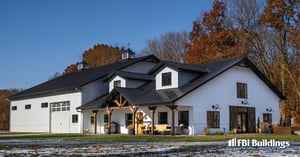 Post frame construction is characterized by the use of solid wooden posts secured into the ground. Fewer materials are needed for a post frame building than a stud-wall construction because the posts and interlocking frame can sustain higher loads.
Post frame construction is characterized by the use of solid wooden posts secured into the ground. Fewer materials are needed for a post frame building than a stud-wall construction because the posts and interlocking frame can sustain higher loads.
Post frame buildings also feature large wall cavities that are ideal for adding insulation.
Two of the most significant advantages of post frame construction are that it is less expensive and quicker to erect than other construction methods. Cost and time savings contribute significantly to the popularity of this style of building for residential uses like barndominiums, shouses, garages, hobby shops, workshops, and animal confinement applications.
Post frame buildings can also add to the aesthetic curb appeal of your property with durable and long-lasting construction made with high-quality building materials.
Building Design Flexibility
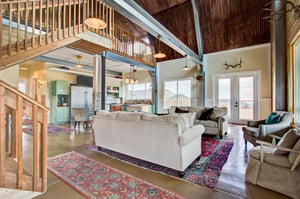 Stick frame construction using wood studs or structural steel on top of a concrete slab, basement, or crawlspace foundation is what most people think of traditional home building design.
Stick frame construction using wood studs or structural steel on top of a concrete slab, basement, or crawlspace foundation is what most people think of traditional home building design.
The framing is typically constructed with studs and trusses every 16” to 24” on-center using interior walls for structural support.
Post-frame construction uses large posts or laminated columns, and trusses to transfer its load directly into the ground. Posts or columns are typically buried 4-6 feet into the ground to maximize strength and support.
Posts or columns are spaced 8’ on center and roof trusses are spaced 2’ to 8’ on center depending on load requirements and desired interior finishes. Therefore, post frame buildings do not need interior load-bearing walls.
This design difference from stick frame construction is how they accomplish their vast open interior spaces that are well suited for residential projects.
Material Selection Options
Metal wall and roof panels are popular choices for post frame buildings, but not all metal panels are created equally.
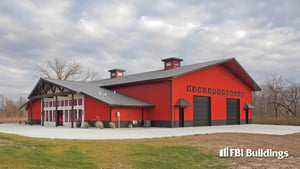 Many homeowners hear about the long lifespan of metal panels and believe that price is the only consideration when shopping around for a panel style.
Many homeowners hear about the long lifespan of metal panels and believe that price is the only consideration when shopping around for a panel style.
However, there is a big difference in quality, longevity, and durability between a “painted metal” panel and a high-performing metal panel that features a Galvalume steel substrate and a Kynar 500® (PVDF) coating/paint system.
The substrate and coating are two significant considerations you should be aware of when selecting a metal panel.
The substrate is the core of the metal panel. The two most common substrates are Galvanized and Galvalume. Galvanized substrates are coated in zinc, while Galvalume substrates are coated with an alloy of zinc plus aluminum.
Both are suitable for metal panel construction, but Galvalume substrates offer the best performance and longest service life. In fact, steel mills warranty Galvalume substrates against rupture or perforation due to corrosion. Similar warranties do not exist for Galvanized options.
A coating, or paint, is the part of your panel that will bear the brunt of the elements. UV rays, rain, and everything else nature throws at your building will be directly impacting the coating. So, it’s crucial to select a coating system that will hold up over time.
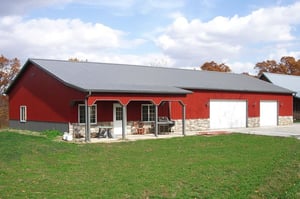 Kynar 500® systems offer the best performance, protecting against chalk and fade. There are other paint systems on the market that are typically less expensive than Kynar 500 systems, but they offer lower performance and are more prone to chalk and fading.
Kynar 500® systems offer the best performance, protecting against chalk and fade. There are other paint systems on the market that are typically less expensive than Kynar 500 systems, but they offer lower performance and are more prone to chalk and fading.
Which substrate and coating are right for you will be determined by your application. For instance, if you are building a basic shade and shelter structure, you might be less concerned about long-term performance and appearance.
A home, garage, or other structure that will be highly visible and expected to perform for years to come would warrant a higher quality substrate and coating system.
Cons of Post Frame Home Construction
Cost is always a function of design and materials. Post frame homes can be less than traditionally built homes but not always. Eliminating a basement does save some cost but it may be offset by other additional costs added to the design like custom porches, workshops, and larger garages. The devil is in the details when it comes to cost.
Zoning for post frame homes varies widely depending on your location. some towns do not allow post frame homes, but that is typically due to a lack of experience with post frame homes.
We recommend contacting post frame builders in your area who may have had some experience with home building and would will be willing to meet with local officials to educate them about the advantages of post frame home construction. Post frame buildings other than homes face fewer zoning concerns.
Valuing a post frame home in some areas may be a challenge for appraisers and loan officers since they are often not a true comparison to a traditionally built home. As more post frame homes are built, this issue will occur less.
Mortgage requirements vary, but you can be sure you will need to answer a lot more detailed questions about the specifics of your home design. Some lenders require 50% living space and a concrete footing below ground level. Be sure to ask these questions of your designer and builder early in the process.
Learn More
You can learn more about post frame construction, panel selection, and explore project photos here.
About McElroy Metal
Since 1963, McElroy Metal has served the construction industry with quality products and excellent customer service. The employee-owned components manufacturer is headquartered in Bossier City, La., and has 14 manufacturing facilities across the United States. Quality, service and performance have been the cornerstone of McElroy Metal’s business philosophy and have contributed to the success of the company through the years. As a preferred service provider, these values will continue to be at the forefront of McElroy Metal’s model along with a strong focus on the customer.

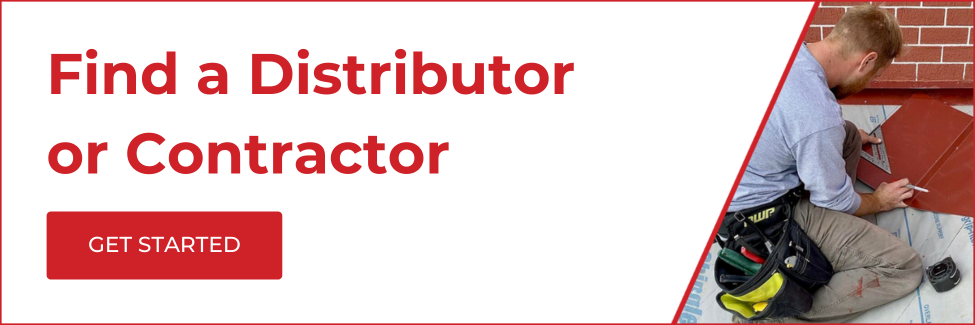

.png?width=767&name=Metal%20Roofing%20for%20Event%20Centers,%20Arenas%20%20&%20Sports%20Facilities%20(1).png)

.png?width=767&name=Barndominiums%20and%20Shouses%20Designing%20for%20Modern%20Living%20with%20Metal%20Components%20(1).png)



Comments on this article:
Scroll down to the bottom to submit a comment and join the conversation. Need help or have a question? Please contact us. Looking for a distributor or contractor? Please click here to get started.